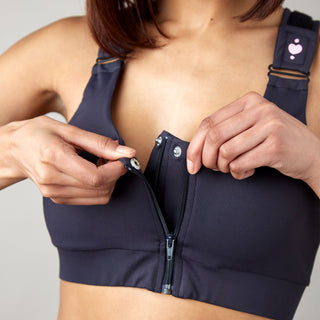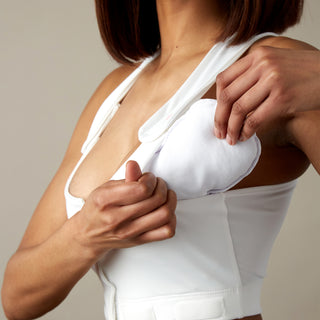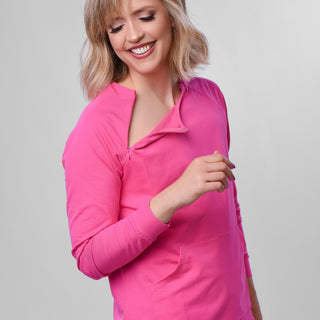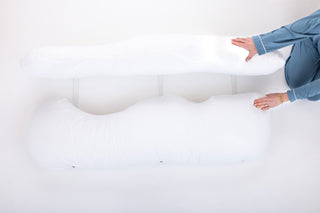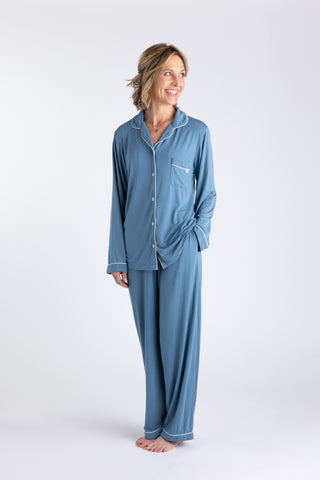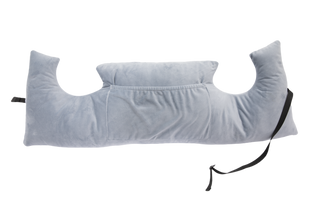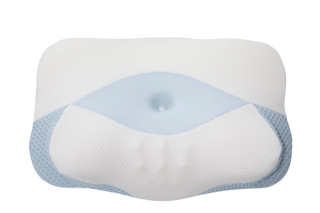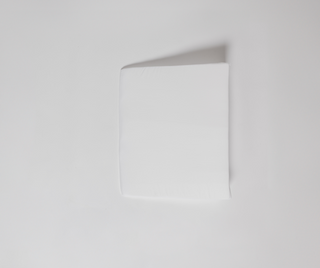Let's talk about the reality nobody mentions in those pre-surgery consultations: after lung surgery, your relationship with bras becomes more complex than solving a puzzle where half the pieces have gone missing. One day you're reaching behind your back without a second thought, and the next day that same motion feels like attempting a Cirque du Soleil performance—except with surgical staples and strict "no twisting" orders from your surgeon.
If you're reading this, chances are you're either preparing for lung surgery or you're in recovery wondering why your favorite bra now feels like a contraption designed by someone who's never worn one. Here's the honest truth: your pre-surgery lingerie drawer is about as useful as a chocolate teapot right now, but that doesn't mean you're doomed to shapeless sports bras forever.
Welcome to your crash course in post-lung surgery bra navigation—where healing meets practicality, and choosing the right support becomes as important as any other part of your recovery plan.
Understanding Your Needs
The Reality Check: Why Your Old Bras No Longer Work
Lung surgery is a major medical procedure that impacts your entire chest area. Whether you've undergone a lobectomy, pneumonectomy, wedge resection, or any other thoracic procedure, your chest has been through a significant trauma. Your surgeon likely made incisions between your ribs, moved muscles around, and possibly removed part or all of a lung. Your body is working overtime to heal, and every movement matters.
At a Glance: Why Pre-Surgery Bras Don't Work
-
Require behind-the-back reaching and twisting
-
Create pressure points on healing incisions
-
Interfere with essential breathing exercises
-
Can't accommodate surgical drains
-
Amplify post-surgical pain
Here's why your pre-surgery bras are now about as helpful as snow boots in summer:
The Reach-Around Impossibility: Traditional back-hooking bras require you to reach behind your back, twist your torso, and manipulate tiny hooks—movements that are either impossible or inadvisable after chest surgery. Your range of motion is limited for good reason, and fighting with bra hooks isn't worth the risk of disrupting your healing.
Pressure Point Problems: Underwire bras that once provided lift and support now press directly on healing incisions. The underwire placement now sits exactly where your surgeon made their carefully planned incisions.
The Breathing Barrier: After lung surgery, deep breathing exercises aren't just recommended—they're essential for preventing pneumonia and maintaining lung function. Tight bras or constricting bands can interfere with these crucial exercises and make proper lung expansion difficult.
Drain Management Hassles: Many lung surgery patients go home with chest tubes or drainage systems. Traditional bras weren't designed to accommodate medical devices, turning drain management into a daily wrestling match.
Pain Amplification: Everything hurts more after surgery, and pressure in the wrong places can turn tolerable discomfort into unbearable pain. The wrong bra can make you feel like you're being squeezed by an overzealous python.
Understanding Your Recovery Timeline
Recovery from lung surgery isn't linear, and neither are your bra needs. Understanding what to expect can help you plan ahead and avoid the frustration of buying the wrong thing at the wrong time.
Early Recovery (First 1-6 Weeks)
During this critical healing phase:
-
Surgical pain and chest tenderness are significant
-
Limited arm and shoulder mobility due to incision protection
-
Chest tubes or drains requiring management (typically first 1-2 weeks)
-
Breathing exercises are essential but challenging
-
Swelling around surgical sites fluctuates daily
-
Hypersensitive skin reacts to everything
Bra Priority: Front-closing options with zero incision pressure. Focus on drain accommodation and breathing exercise compatibility. Soft fabrics and infinite adjustability are non-negotiable.
Mid Recovery (6-12 Weeks)
As lung function begins to normalize:
-
Pain becomes more manageable, breathing exercises feel easier
-
Range of motion improves, but still limited by healing chest muscles
-
Chest tubes removed, but incision sites remain tender
-
Return to light activities and possibly work
-
Scar tissue begins forming along incision lines
-
Energy levels start improving as lung capacity increases
Bra Priority: Structured support without compromising healing. Seamless construction becomes important as scar tissue develops. Need adjustability for fluctuating comfort levels.
Late Recovery (3+ Months)
Approaching your new normal:
-
Most physical restrictions lifted, breathing feels more natural
-
Range of motion nearly or fully restored
-
Scars maturing and becoming less sensitive
-
Ready for normal activities as lung function stabilizes
-
May feel confident enough for more traditional bra styles
Bra Priority: Can begin transitioning to more conventional styles, though many patients prefer the comfort innovations they discovered during recovery.
Choosing the Right Bra
Essential Features: What Makes a Post-Lung Surgery Bra Worth Your Money
Not all post-surgical bras are created equal, and definitely not all "comfortable" bras are suitable for recovery. Here's what actually matters when you're healing from lung surgery:
Front Closure with Medical-Grade Velcro: Your New Best Friend
This isn't just about convenience—it's about safety and healing optimization. Front-closing bras eliminate the need for behind-the-back reaching and twisting, movements that can stress healing tissues and potentially disrupt your recovery.
Critical Feature: Medical-Grade Velcro vs. Hook-and-Eye
Why Medical-Grade Velcro is Essential:
-
Zero Fine Motor Skills Required: Hook-and-eye closures demand precision and dexterity that post-surgical patients often lack due to pain medication, reduced mobility, or post-anesthesia effects
-
One-Handed Operation: Velcro closures can be managed with one hand, crucial when you're protecting surgical sites or dealing with limited range of motion
-
Infinite Adjustability: Unlike fixed hook positions, Velcro allows micro-adjustments throughout the day as comfort levels and swelling fluctuate
-
Silent Operation: Important for partners' sleep when you need to adjust support during the night
-
No Sharp Edges: Hook-and-eye closures can scratch sensitive, healing skin or catch on surgical dressings
Quality post-lung surgery bras completely eliminate traditional closures, using soft medical-grade Velcro systems that you can manage even with limited dexterity or when experiencing post-surgery brain fog.
SHOP HEART&CORE POST-SURGERY BRAS
Materials That Matter for Healing
Post-lung surgery skin becomes hypersensitive, making fabric choice crucial for both comfort and healing. heart&core has pioneered many of these material innovations specifically for post-surgical patients:
-
Premium Fabric Blends (95% nylon/5% spandex): These advanced blends aren't just about comfort—they're engineered for medical recovery. The specific ratio provides consistent therapeutic compression without restricting the deep breathing exercises essential for lung surgery recovery. Unlike cheaper blends that lose elasticity quickly, quality fabrics maintain their therapeutic properties through repeated washing, ensuring consistent support throughout your entire recovery period.
-
Moisture-Wicking Capabilities: This isn't just about comfort—it's about preventing infections at chest incision sites. Post-lung surgery patients need to focus on healing without the added risk of bacterial complications. Advanced moisture-wicking fabrics actively transport perspiration away from vulnerable surgical sites, creating a dry environment that inhibits bacterial proliferation and promotes optimal wound healing.
-
Antimicrobial Properties: When your body is focused on healing from thoracic surgery, every layer of infection protection matters. Fabrics treated with antimicrobial agents provide continuous protection against harmful bacteria, fungi, and other pathogens that could compromise healing or cause serious complications at chest incision sites.
-
Silky-Smooth Medical-Grade Textures: This stark contrast to rough, institutional hospital-provided garments isn't about luxury—it's about preventing secondary complications. Medical-grade smooth textures eliminate friction that could disrupt healing tissues or create new wounds requiring treatment, addressing the hypersensitive skin that develops after lung surgery.
-
Engineered Breathability: Unlike regular bras that may trap heat and moisture, medical-grade breathable fabrics allow essential air circulation. This supports your body's natural temperature regulation during healing, prevents the warm, moist conditions where harmful bacteria thrive, and ensures comfort during the extended wear periods often required after lung surgery.
Material Reality: These fabric innovations represent the difference between medical-grade and retail materials that can literally impact your healing timeline and infection risk. This isn't fashion—it's specialized medical equipment designed as clothing.
Design Details That Make or Break Your Recovery Experience
Small design elements can have an outsized impact on recovery outcomes—these aren't comfort features, they're medical necessities. heart&core has developed many of these thoughtful design innovations specifically for healing patients:
-
Wide, Cushioned Strap Engineering: After lung surgery, pressure distribution becomes a medical concern. Narrow straps can create uncomfortable pressure points that impede circulation and cause shoulder and neck pain—pain that can interfere with the essential breathing exercises critical for lung surgery recovery. Wide straps distribute weight across a larger surface area, supporting proper circulation and preventing the discomfort that could limit your ability to perform necessary respiratory therapy.
-
Integrated Drain Management Systems: Chest tubes and drainage systems are life-saving medical devices that require secure, comfortable positioning. Improvised drain management using safety pins or makeshift solutions creates infection risks and can compromise drainage effectiveness. Purpose-built drain tabs and management features keep drainage bulbs properly positioned, prevent tubing kinks that could cause dangerous fluid backup, and eliminate the infection risks associated with improvised solutions.
-
Seamless Medical Construction: When healing skin becomes hypersensitive after thoracic surgery, even small seams can cause significant problems. Rough seams can create pressure sores, skin breakdown, or infection entry points. Seamless construction eliminates these risks while preventing the itching and scratching that can disrupt sleep—essential for healing and recovery from lung surgery.
-
Strategic Medical Coverage: Post-lung surgery bras provide extended coverage not for modesty, but for medical protection. This coverage protects vulnerable chest incision sites from environmental contaminants, provides gentle compression to support healing tissues, and creates a barrier against accidental impacts that could disrupt internal healing.
-
Adjustability for Recovery Fluctuations: Your body changes daily during recovery—swelling fluctuates, comfort levels vary, and your needs evolve. Look for multiple adjustment points including straps, band, and closure adjustability with wide adjustment ranges to accommodate changes without needing new bras.
Critical Medical Insight: These design features aren't upgrades—they're medical necessities. The wrong design choices can directly lead to complications, extended healing times, or serious medical issues like infection or impaired breathing recovery.
Special Considerations for Lung Surgery Recovery
Sleep Considerations
Many lung surgery patients find they need to sleep elevated or in specific positions, making nighttime bra choices important:
-
24-hour comfort: If your surgeon recommends wearing a bra to sleep, choose styles designed for extended wear
-
Position compatibility: Bras that work whether you're sleeping upright, on your side, or in whatever position you find comfortable
-
Temperature regulation: Night sweats are common during recovery, making breathable fabrics essential
- Full-body sleep support: A full-body post-surgery pillow is recommended for supporting elevated back sleeping following lung surgery.
Scar Care Integration
As your incisions heal, scar formation becomes a consideration:
-
Smooth surfaces: Prevent snagging on developing scar tissue
-
Gentle pressure: Some patients benefit from light pressure over healing scars, but this should be discussed with your healthcare team
-
Easy scar access: For applying recommended scar treatments or for medical examinations
Living with Your Recovery Bra
The Psychology of Post-Surgery Dressing
Let's talk about something often overlooked: the emotional aspect of getting dressed after major surgery. Your relationship with your body has changed, your capabilities are temporarily different, and sometimes getting dressed feels like a defeat rather than a victory.
This is completely normal and valid. Your pre-surgery self could probably get dressed in the dark while thinking about grocery lists. Post-surgery you might need to plan your outfit the night before and still struggle with buttons. This doesn't make you weak—it makes you human and healing.
Emotional Recovery Insight: A good post-surgical bra can be the difference between starting your day feeling defeated or feeling capable. When you find the right fit, getting dressed becomes one less challenge in a day that might already feel full of obstacles.
Day-to-Day Strategies: Making Bras Work in Your Real Life
📋 Essential Preparation Checklist
The Two-Bra Minimum
Plan to have at least two good post-surgical bras. Here's why:
-
Hygiene: You need one to wear while washing the other
-
Comfort rotation: Some days you'll need different levels of support
-
Backup security: Having a backup reduces stress if something happens to your primary bra
Morning Routine Modifications
Getting dressed post-surgery requires strategy:
-
Prepare the night before: Lay out your clothes, including your bra
-
Warm up first: Gentle shoulder rolls or arm circles can make dressing easier
-
Take your time: Rushing leads to discomfort and potential setbacks
-
Ask for help: There's no shame in needing assistance, especially in early recovery
Activity-Based Choices
Different activities may require different bra features:
-
Medical appointments: Easy removal for examinations
-
Physical therapy: Secure support that won't shift during exercises
-
Sleeping: Maximum comfort for extended wear
-
Social activities: Options that work under your preferred clothing
Warning Signs It's Time to Reassess
Your bra needs will evolve during recovery. Time for a change when:
-
Increased discomfort: If your bra suddenly feels uncomfortable, your body may be changing
-
Visible red marks: Marks that don't fade within 15 minutes indicate too much pressure
-
Breathing difficulty: Any interference with breathing requires immediate adjustment
-
Fit changes: Significant looseness or tightness means it's time to re-evaluate
Practical Considerations
Practical Purchasing Guide
Finding Quality: What to Look for in Brands and Products
The post-surgical bra market ranges from basic comfort options to sophisticated medical-grade garments. When evaluating brands, consider companies that specialize in post-surgical needs rather than general lingerie brands.
📋 Brand Evaluation Checklist
When evaluating brands, consider:
-
Medical focus: Companies that specialize in post-surgical garments understand healing bodies better than general lingerie brands
-
Healthcare provider endorsement: Brands recommended by hospitals or surgeons have typically proven their effectiveness
-
Patient reviews: Real experiences from other lung surgery patients provide invaluable insights
-
Return policies: Good companies stand behind their products and offer exchanges if the fit isn't right
Insurance and Financial Considerations
Post-surgical bras may be covered by insurance with proper documentation:
Getting Coverage:
-
Get a prescription: Ask your surgeon for a prescription for post-surgical bras
-
Keep receipts: Save all documentation for insurance claims
-
Check coverage: Contact your insurance company to understand your specific benefits
-
Use proper coding: Post-surgical bras are often covered under durable medical equipment
Alternative Funding Options:
-
HSA/FSA eligibility: Health savings accounts often cover post-surgical garments
-
Patient assistance programs: Some companies offer financial assistance for post-surgical patients
-
Hospital resources: Ask your surgical team about patient assistance programs or loaner programs
The Gradual Transition: Moving Back to "Normal" Bras
Eventually, you may want to transition back to more traditional bra styles. This isn't a race, and there's no prize for getting back to underwire fastest. Some patients find they prefer the comfort features they discovered during recovery and never go back to their old styles.
When you're ready to experiment:
-
Start gradually: Try traditional styles for short periods first
-
Keep your recovery bras: They're excellent for sick days, lazy weekends, or times when you just want maximum comfort
-
Listen to your body: If something doesn't feel right, trust that instinct
Common Mistakes to Avoid
🚫 Recovery Mistakes That Cost Comfort and Money
Learning from others' experiences can save you discomfort and money:
-
Buying too small: Swelling and sensitivity mean you likely need larger sizes than you think
-
Prioritizing appearance over function: This isn't the time for fashion-first choices
-
Assuming all "comfortable" bras work: General comfort bras aren't designed for surgical recovery
-
Wearing underwire too early: Even when it doesn't hurt, underwire can interfere with optimal healing
-
Ignoring fit changes: Your needs will evolve throughout recovery—what worked week one might not work week six
Beyond Basic Recovery
When Standard Advice Doesn't Apply
Multiple Surgeries
If you've had multiple thoracic surgeries, your comfort needs may be more complex. Previous scar tissue, multiple incision sites, or complications can all affect what works for you.
Radiation Therapy
If your treatment plan includes radiation, your skin will become increasingly sensitive. You may need to switch to even softer fabrics or specialty products designed for radiation patients.
Active Lifestyle Return
Athletes or very active individuals may need specialized sports bras designed for post-surgical bodies. These combine the support needed for activity with the gentleness required for healing tissues.
Size Fluctuations
Some medications or treatments can cause significant weight or size fluctuations. Bras with maximum adjustability become even more important in these situations.
When to Seek Help
Don't hesitate to reach out for professional help when:
-
Persistent discomfort: If you can't find comfortable options, a certified fitter experienced with post-surgical needs can help
-
Skin issues: Rashes, persistent red marks, or skin breakdown require medical attention
-
Breathing problems: Any bra that interferes with breathing needs immediate adjustment
-
Emotional struggles: If clothing challenges are affecting your mental health, talk to your healthcare team

FAQ: Your Most Pressing Lung Surgery Questions Answered
Immediate Recovery Concerns (First 6 Weeks)
How long will I need special post-lung surgery bras?
This varies widely between individuals and the type of lung surgery performed. Some patients transition back to regular bras within 3-6 months, while others prefer the comfort features permanently. Your healing timeline and breathing comfort should guide your decisions.
Can I sleep in my post-surgical bra after lung surgery?
Many post-surgical bras are designed for 24-hour wear, but check with your thoracic surgeon. Some lung surgery patients benefit from continuous support to prevent movement that could stress healing tissues, while others heal better with periods of freedom from compression.
How do I manage chest tubes with my bra?
Look for bras with built-in drain management features or discrete pockets for drainage bulbs. Never use safety pins or improvised solutions that could create infection risks. Purpose-built drain management keeps tubes properly positioned and prevents dangerous kinks.
What if my bra feels too tight when I do breathing exercises?
Your bra should never restrict the deep breathing exercises essential for lung surgery recovery. If you feel constrained during respiratory therapy, loosen the closure or switch to a less compressive option. Proper lung expansion takes priority over support.
Ongoing Recovery Questions (6-12 Weeks)
When can I start wearing underwire again after lung surgery?
Wait until your thoracic surgeon clears you for normal activities and your chest incisions are fully healed. Underwire can press on healing lung surgery incision sites and interfere with the chest expansion needed for optimal recovery. Even then, transition gradually.
What about sports bras for exercise after lung surgery?
Once cleared for exercise, you may need specialized post-surgical sports bras that provide activity support without compromising breathing or healing chest tissues. Traditional sports bras may be too constrictive for the deep breathing your recovering lungs need during activity.
How do I know if my bra is affecting my breathing or lung function?
Signs include difficulty with breathing exercises, feeling short of breath when the bra is on but better when removed, or inability to take the deep breaths your respiratory therapist recommends. Any interference with breathing requires immediate bra adjustment or removal.
Long-Term Considerations (3+ Months)
Will my lung capacity affect what bras I can wear long-term?
Some patients find that their breathing comfort influences their bra choices permanently. If you've had significant lung tissue removed, you may prefer wire-free, less constrictive options even after full healing to support optimal remaining lung function.
What if my chest shape changed after lung surgery?
Lung surgery can alter chest contours, especially after lobectomy or pneumonectomy. You may need different cup styles or asymmetrical solutions. Many post-surgical bra companies offer fitting consultations for patients with altered chest anatomy.
How do I care for my post-lung surgery bras?
Hand wash when possible to preserve the medical-grade materials that support your recovery. Air dry to maintain elastic properties crucial for proper chest support. Replace every 4-6 months with regular use, or sooner if you notice decreased support that could affect your comfort during breathing exercises.
The Bottom Line: Your Recovery, Your Rules
Recovering from lung surgery is challenging enough without adding unnecessary discomfort from ill-fitting undergarments. The right post-surgical bra won't cure your recovery challenges, but it can remove one significant source of daily discomfort.
Remember that recovery isn't linear, and neither are your comfort needs. What works today might not work next week, and that's completely normal. Be patient with yourself, invest in quality options when possible, and don't hesitate to ask for help when you need it.
Your journey back to normal includes rediscovering comfort and function in every aspect of your daily routine, including getting dressed. The right bra is a tool in that journey—not the destination, but a crucial support system that can make each day a little easier.
Most importantly, "normal" doesn't have to mean returning to exactly what you did before surgery. Many patients discover that the comfort features they needed during recovery—like front closures and wire-free support—actually improve their daily quality of life permanently. Sometimes the best part of getting back to normal is realizing you can redefine what normal means for you.
Your body has been through something significant, and it deserves garments that support its healing journey. Give yourself permission to prioritize comfort over appearance, function over fashion, and healing over everything else. The rest will follow when you're ready.
Disclaimer
This article provides general information about post-surgical bra considerations and should not replace medical advice from your healthcare providers. Always follow your surgeon's specific post-operative instructions regarding clothing, activity restrictions, and healing protocols.
Individual recovery experiences vary significantly, and what works for one patient may not be appropriate for another. Consult with your surgical team about your specific needs, especially regarding compression levels, wear schedules, and when to transition between different types of support garments.
If you experience any unusual symptoms, persistent pain, signs of infection, or concerns about your recovery, contact your healthcare provider immediately. This article is intended for educational purposes only and should be used in conjunction with professional medical guidance throughout your recovery journey.



